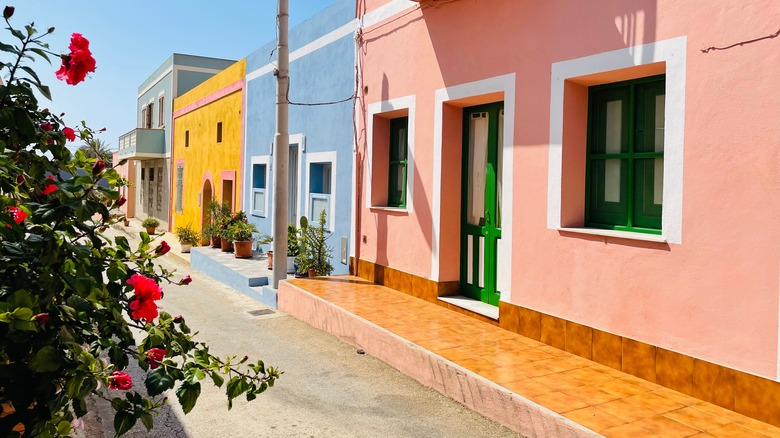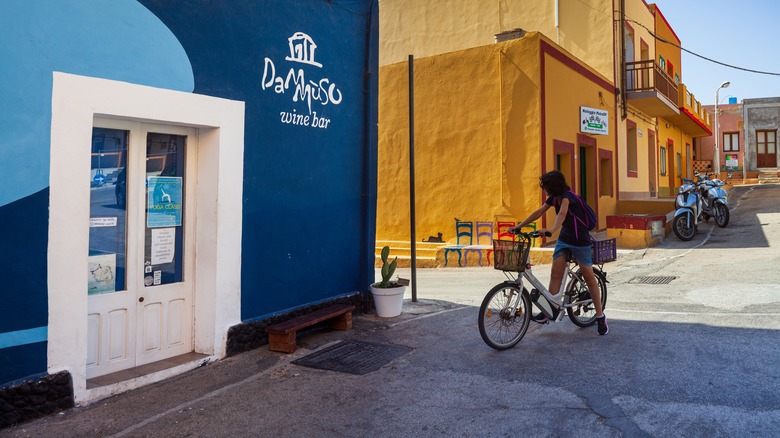If you want to get away from it all on a little island with only 430 inhabitants, look no further than Linosa. Floating in the Mediterranean Sea, the small island of Linosa, part of the Pelagie archipelago along with Lampedusa and Lampione, is a serene escape from the hustle and bustle of mainland Europe. With a colorful downtown and untouched landscape, it’s an ideal destination for those seeking a peaceful retreat.
Linosa is situated between Sicily and Tunisia, closer to Africa than the Italian mainland. It’s a volcanic island, part of the Sicilian province of Agrigento. The island’s area of 2.1 square miles is shaped by volcanic origins, featuring craggy cliffs, black coasts, green hills, and three extinct volcanic craters. One of these is Monte Vulcano, rising 640 feet above sea level. It’s also the highest point on the island, and the walk to the peak is particularly rewarding. Linosa offers a range of other hiking trails that meander through its rugged terrain with views of the Mediterranean.
Despite its small size, Linosa is remarkably biodiverse. The island is part of a protected marine area established to preserve its unique environment. For wildlife and conservation enthusiasts, CRTM Linosa Rescue Center may be a point of interest. Linosa is a vital nesting site for Caretta Caretta loggerhead turtles and the second-largest breeding colony of Calonectris Diomedea seabirds. These birds, also known as Berte Maggiore (which happens to be Linosa’s alternative name), are believed to have inspired the ancient myth of sirens.
Emerald waters and pastel downtown: Linosa

The surrounding emerald waters of Linosa offer excellent opportunities for snorkeling and diving, with underwater caves and plentiful marine life. Secchitella is a highly recommended dive site, with pinnacles going down to 230 feet. Sailing is popular as well, and you can book tours to go around the island by boat (check Grotta del Greco on your excursion).
The coastline is dotted with secluded beaches, where the waters are crystal-clear and perfect for swimming. One of the most famous is Cala Pozzolana di Ponente, known for its black volcanic sand beach and stunning sunsets. The Piscine (natural rock pools), Punta Beppe Tuccio (small promontory lagoon), and Cala Pozzolana di Levante are other beaches and swimming holes that are untouched and uncrowded.
Linosa’s downtown is lined with little square houses painted in bright hues, creating a cheerful atmosphere. This kaleidoscope of pastel colors reflects Linosa’s lively spirit and sets a quaint backdrop for the very few cafes and even fewer shops dotting the area. The island’s perimeter of under seven miles can be trodded entirely on foot in a few hours. Bikes and scooters are available for rent by the day.
Accommodations are intimate and welcoming. No fancy hotels or chains here — only wholesome, family-run bed and breakfasts such as Hotel Pelaghea and B&B Residence La Posta. The best time to visit Linosa is from May to November, but the island is barren and does get scorching temperatures with little shade in July and August.
Island life, cuisine, and travel tips

One of Linosa’s most charming aspects is its slow-paced lifestyle, allowing visitors to unwind and disconnect from the outside world. There are no banks, no car rentals, and no discotheques. During the high season of July and August, there will be at most 50 holidaymakers. Linosa’s small population is warm and inviting, offering a glimpse into true Italian island life. “After a few days, you become islanders, too,” says sixth-generation Linosani Alberto Ramirez, who runs B&Bs there (via AP News).
The culinary scene in Linosa is as authentic as it gets. The local cuisine is a mix of Sicilian and Mediterranean flavors, with an emphasis on fresh seafood. From lentil soup to buccellati (biscuits stuffed with fig), prickly pear ice cream to grilled fish, the dishes are modestly priced and prepared with locally sourced ingredients, offering an authentic taste of island life. Linosa is known for its local production of capers, lentils, figs, and grapes. Some of the most popular restaurants include Da Anna, Errera, and Dammùso Wine Bar.
Reaching Linosa is an adventure in itself. The island is accessible only by ferry from Lampedusa or Porto Empedocle in southern Sicily, with the journey offering breathtaking views of the Mediterranean Sea. Check routes with Siremar or Liberty Lines. Flying in is not an option, as there isn’t an airport on the island. This remote location adds to Linosa’s charm, making it a perfect escape for those looking to get away from it all.

